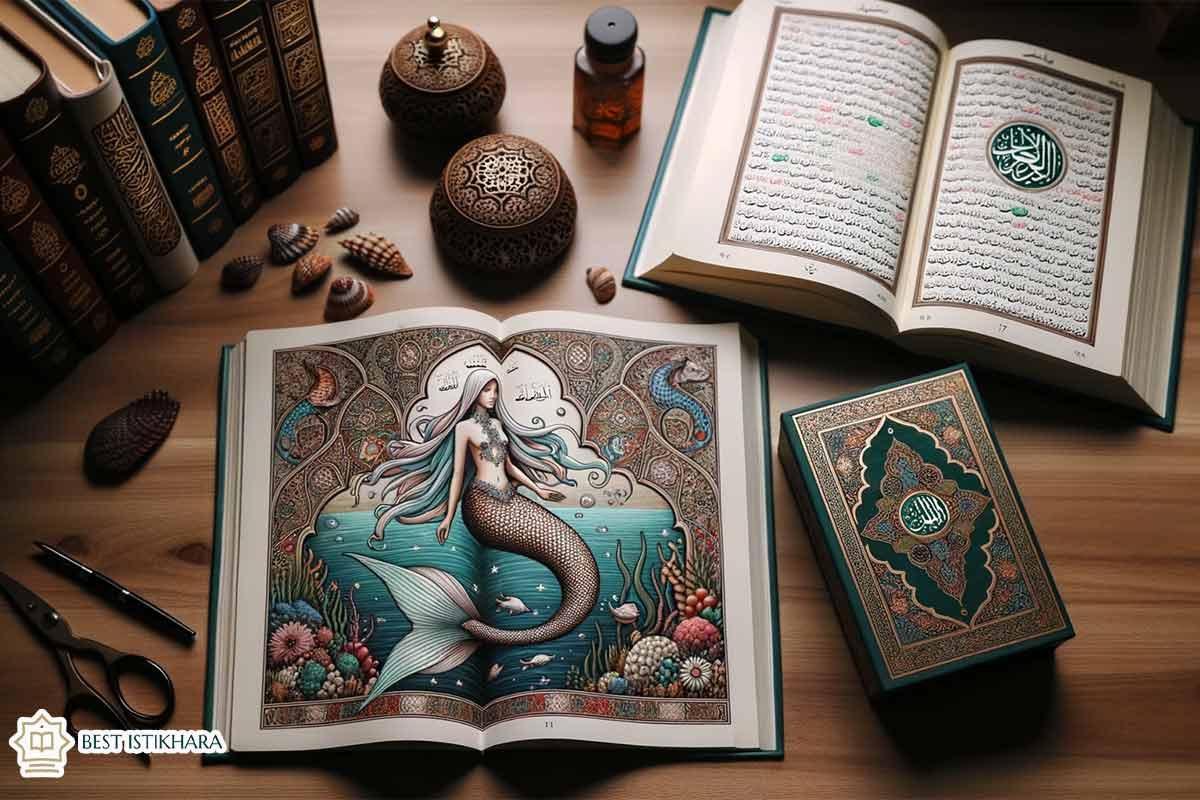Dreams have always held a unique position in various cultures and religions around the world, often believed to carry profound messages from the subconscious mind, divine entities, or even omens about the future. Within the Islamic tradition, dreams, or ru’ya, are given significant attention, with entire works dedicated to their interpretation based on teachings from the Quran and the Hadith. Among the myriad symbols one might encounter in their nocturnal visions, the figure of the mermaid, a half-human, half-fish creature, remains one of the most enigmatic. While mermaids are more commonly associated with folklore and myths of other cultures, their appearance in the dreams of Muslims prompts a quest for deeper understanding. This article will explore the significance of mermaids within the realm of Islamic dream interpretation, drawing connections with classical Islamic texts, and delving into the layers of meaning these mystical creatures might represent. Whether a symbol of temptation, mystery, or spiritual journey, mermaids invite dreamers to plunge into the depths of their psyche and the vast ocean of Islamic symbolism. If you want to read more about this topic, follow the dream interpretation in Islam.
What is the Islamic Interpretation of Seeing a Mermaid in a Dream?
In Islamic tradition, dreams hold a significant position and are believed to be one of three types, as mentioned by the Prophet Muhammad (peace be upon him): truthful dreams (glad tidings from Allah), distressing dreams (from Satan), and dreams from one’s own thoughts and desires. The interpretation of dreams in Islam is derived mainly from the teachings of the Quran and the Hadith, as well as the insights of scholars and dream interpreters. The presence of certain symbols in dreams, like animals, water, or particular situations, often has established interpretations based on these sources. That being said, mermaids are not explicitly mentioned in the primary Islamic scriptures, so there isn’t a standardized or canonical interpretation of seeing a mermaid in a dream. However, considering Islamic dream interpretation principles and the symbolism attached to components of the mermaid, we can infer potential meanings:

- Water Symbolism: Since mermaids are creatures of the water, and water in Islamic dream interpretation can symbolize life, sustenance, knowledge, or the state of one’s faith, seeing a mermaid might relate to one’s spiritual or emotional state. The condition of the water (calm, turbulent, clear, murky) can further clarify this.
- Duality and Temptation: Mermaids, being half-human and half-fish, could symbolize duality or conflict. They might represent a struggle between one’s desires and one’s faith or the temptations of this world versus spiritual pursuits.
- Mystical or Hidden Knowledge: Just as mermaids are elusive and mysterious, they could symbolize hidden truths, secrets, or a journey to understand deep spiritual knowledge.
- Femininity and Desire: The mermaid, often depicted as a beautiful woman, could represent aspects related to femininity, beauty, and desire.
- Protection or Warning: Depending on the context of the dream, a mermaid might serve as a protector or a warning sign. For instance, if the mermaid guides the dreamer through turbulent waters, it could be seen as a protective symbol.
- Connection with Jinn: Since mermaids are mythical and not human, some interpretations might relate them to the world of the jinn or unseen beings.
Dream interpretation in Islam emphasizes personal context. The individual’s life circumstances, emotions during the dream, and specific details of the dream all play vital roles in deriving a meaningful interpretation. It’s often recommended for individuals to seek guidance from knowledgeable scholars or experienced dream interpreters for a deeper understanding.
Comparing Mermaid Dream Interpretations across Different Cultures
- Islamic Interpretation:
- As previously discussed, there isn’t a direct canonical interpretation of mermaids in Islam.
- Water, which mermaids are associated with, can symbolize life, sustenance, or one’s spiritual state in Islamic dream interpretation.
- They may represent a duality, signifying the struggle between worldly desires and spiritual pursuits, or can symbolize hidden knowledge, femininity, and desire.
- Western Cultures:
- Mermaids in western folklore often symbolize enchantment, mystery, and unattainable desires. Dreaming of them might suggest a longing for something or someone out of reach.
- They can also symbolize a connection or yearning for the deep, intuitive aspects of the self.
- In some interpretations, they represent a dangerous temptation that might lead the dreamer astray, drawing parallels with the sirens of Greek mythology.
- African Cultures:
- In some African mythologies, water spirits or mermaid-like beings called “Mami Wata” are venerated.
- Dreaming of these beings can have dual interpretations: they can either be a sign of blessing and prosperity or a warning of potential danger or temptation.
- Asian Cultures:
- In certain Asian cultures, particularly in Japan, mermaid-like creatures known as “ningyo” are believed to carry a curse, and capturing them could bring misfortune.
- Dreaming of such beings could be seen as a warning or omen of impending challenges.
- Native American Cultures:
- While not prevalent, there are tales of water spirits and beings resembling mermaids.
- These beings are often revered and are associated with specific lakes or water bodies.
- Dreaming of them could be a sign of protection, guidance, or a spiritual connection to nature.
- Pacific Islander Cultures:
- Given the close relationship with the sea, mermaid-like beings often appear in folklore.
- They may represent guardianship, ancestors, or the deep ancestral connection to the ocean.
- Dreaming of them might suggest guidance, protection, or a need to connect with one’s roots.
Importance of Context in Interpreting Dreams about Mermaids in Islam
Context is a cornerstone of dream interpretation in Islamic tradition. While there are foundational symbols that have established meanings, understanding a dream fully often requires delving into the dreamer’s personal circumstances, feelings, and the specific nuances of the dream. When interpreting dreams about mermaids in Islam, context becomes particularly significant for several reasons:
- Lack of Direct Scriptural Reference: Since mermaids aren’t explicitly mentioned in primary Islamic scriptures like the Quran and Hadith, there isn’t a standardized interpretation for them. Thus, understanding the dream’s context becomes even more crucial to derive a meaningful interpretation.
- Personal Emotions and Reactions: How the dreamer feels during the dream and upon waking provides invaluable insights. For instance, if a dreamer feels at peace when seeing a mermaid, it might suggest spiritual tranquility or guidance. In contrast, feelings of fear or unease might hint at inner conflicts or warnings.
- Environmental Details: The surroundings in which the mermaid appears can offer added layers of interpretation. For instance, a mermaid seen in clear, calm waters might signify peace, spiritual clarity, or positive transitions. If the waters are turbulent or murky, it might symbolize confusion, challenges, or emotional turmoil.
- Interactions and Events: The nature of the dreamer’s interaction with the mermaid is pivotal. Whether the mermaid is guiding, speaking, singing, or simply observing can lead to various interpretations. Additionally, events leading up to or following the mermaid’s appearance provide context that shapes the dream’s meaning.
- Personal Life Circumstances: Dreams can often reflect the dreamer’s current life situations, concerns, hopes, or fears. If someone is experiencing a crossroads in their life, a mermaid might symbolize the duality of a decision or the allure of a path not yet taken.
- Cultural Influences: While this relates more to a broader context, it’s essential to consider any cultural tales, stories, or personal beliefs the dreamer might have about mermaids, which can influence the dream’s meaning.
- Recurrent Themes: If a dreamer repeatedly sees mermaids or similar symbols, it might indicate an unresolved issue, a persistent message, or a recurring theme in their life that needs attention.
Islamic Scholar’s Views on the Interpretation of Mermaids in dreams
As of my last training cut-off in January 2022, there’s no widely acknowledged or standardized interpretation of mermaids in dreams from renowned Islamic scholars. The primary sources for Islamic teachings, the Quran and the Hadith, don’t directly reference mermaids, making them absent from the canonical dream interpretation lexicon.

However, a few general principles can be inferred based on the methods and approaches classical Islamic scholars use for dream interpretation:
- Interpreting by Components: Some scholars might break down the mermaid symbol into its components for interpretation. For example, considering the human aspect and the aquatic aspect separately. Since water in Islamic symbolism can represent life, knowledge, or the state of one’s faith, this might be a starting point.
- Personal Context: Classical scholars emphasize the importance of the individual’s circumstances. A dream’s meaning can greatly vary based on the dreamer’s personal life, challenges, aspirations, and spiritual state.
- Emotions in the Dream: The feelings experienced during the dream are crucial. Scholars might ask if the dreamer felt fear, peace, confusion, or any other emotion when seeing the mermaid, as this can guide the interpretation.
- Use of Analogies: Islamic dream interpretation often employs analogies based on Quranic stories or prophetic traditions. While mermaids aren’t present in these texts, scholars might draw parallels with other beings or situations that share similar characteristics or themes.
- Seeking Guidance: Islamic tradition encourages seeking the best meanings and always hoping for good interpretations. Scholars would emphasize prayer (dua) and seeking guidance from Allah for clarity regarding any dream.
- Cautious Approach: Scholars usually approach dream interpretation with caution, especially when the symbol isn’t directly rooted in Islamic scriptures. They might refrain from giving a definitive interpretation, suggesting instead that the dreamer reflect on their personal context and pray for clarity.
It’s also important to note that dream interpretation is a specialized field, and not every scholar might venture into it. Those who seek interpretations of such dreams are often advised to approach someone with a known expertise in dream interpretation within the Islamic tradition. As with many topics in the vast world of Islamic teachings, the interpretation might also vary based on the cultural context, school of thought, and the specific scholar’s insights.
Conclusion
In the vast realm of Islamic dream interpretation, the appearance of mermaids offers a tantalizing blend of mystery and introspection. While not directly mentioned in canonical texts, their composite nature intertwines elements of the human psyche with water’s profound symbolism. These mythical beings beckon dreamers to reflect on duality, desire, and spiritual depths. Emphasizing the critical role of personal context, interpretations vary widely, underscoring the intricate tapestry of the individual’s life and emotions. Delving into such dreams invites a deeper exploration of one’s spiritual journey, reminding us of the rich mosaic of symbols Islam embraces.






